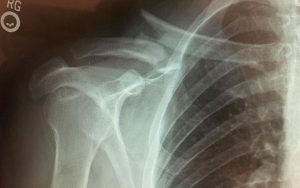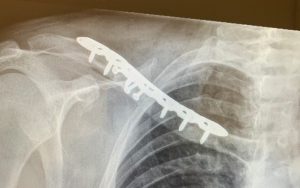4 Lessons from a Surgeon’s Clavicle Surgery: “The Other Side of the Knife”
 Dr. David Kornreich, one of the excellent surgeons at the Orthopaedic Hospital of Wisconsin, recently experienced a clavicle fracture requiring clavicle surgery.
Dr. David Kornreich, one of the excellent surgeons at the Orthopaedic Hospital of Wisconsin, recently experienced a clavicle fracture requiring clavicle surgery.
Orthopedic surgeons often have a unique perspective when they’re on the other side of the knife. Today, Dr. Kornreich candidly relates his experience to help other OHOW patients know what to expect should they go through clavicle surgery. He shares 4 important lessons that he learned to help any patient speed their recovery.
If you experience an orthopedic injury at any time, please contact the professionals at the Orthopaedic Hospital of Wisconsin to help you get back on the road to wellness. We’ll assess your injury and help you decide on the best course of action to return to mobility. Our staff is friendly and relatable, as you’ll discover here in Dr. Kornreich’s account of clavicle surgery for a surgeon.
Dr. Kornriech Shares: My Fracture and Clavicle Surgery
I recently found myself in a situation that I have observed countless times over my 20-year career as an orthopedic surgeon but never experienced firsthand: I was suddenly an orthopedic patient.
After performing countless surgeries in my career at the Orthopaedic Hospital of Wisconsin, I had the chance to experience what we physicians call “the other side of the knife,” where I was surprised to learn some essential lessons to speed my recovery. Here’s the story of my clavicle surgery.
 I was out on a bike ride on a beautiful day. Turning right at the bottom of a gravely, steep-sloped hill in rural Cedarburg, my bike tires slipped, sending me sideways into a ditch. I unclipped my feet from the pedals, found my bearings, and began to take stock of what had just happened. Immediately, I noticed a dull pain in my hip and a more predominant pain in my right shoulder, which led to my suspicion of a broken clavicle.
I was out on a bike ride on a beautiful day. Turning right at the bottom of a gravely, steep-sloped hill in rural Cedarburg, my bike tires slipped, sending me sideways into a ditch. I unclipped my feet from the pedals, found my bearings, and began to take stock of what had just happened. Immediately, I noticed a dull pain in my hip and a more predominant pain in my right shoulder, which led to my suspicion of a broken clavicle.
My wife and daughter picked me up and drove me to the emergency room, where an X-Ray confirmed my suspicion. I had a displaced midshaft clavicle fracture, an injury that was unlikely to heal without surgery.
Being a surgeon who needs surgery has its perks. I was able to call one of my colleagues who was available to perform an open reduction internal fixation of my right clavicle the very next day.
Only around 24-hours after I sustained my injury, I was in the operating room, receiving a general anesthetic, about to go under for clavicle surgery. I was finally able to experience a procedure that I had performed countless times on patients from the other side of the operating table.
 Since I had my clavicle injury treated promptly, I was also able to recover relatively quickly. I was already back to work on Monday under some limitations. I only allowed myself to perform surgeries that did not involve raising my arms above the elbow level. However, I was able to see patients and perform more minor procedures with ease.
Since I had my clavicle injury treated promptly, I was also able to recover relatively quickly. I was already back to work on Monday under some limitations. I only allowed myself to perform surgeries that did not involve raising my arms above the elbow level. However, I was able to see patients and perform more minor procedures with ease.
About eight weeks after my clavicle injury, I was able to get back to the rigors of more extensive surgeries. My expedited surgical process allowed me to get back to doing what I love—helping OHOW patients.
4 Lessons from My Clavicle Surgery
While my experience fracturing my collarbone was not the most pleasant experience, going on “the other side of the knife” furthered my understanding of the entire process patients experience, from injury to recovery.
If you find yourself in a similar situation to mine, here are 4 vital lessons I learned as a patient that helped with my swift and healthy recovery from clavicle surgery.
1. Timing of Treatment is Everything
One of the most eye-opening lessons from my experience was how quickly patients can, and should, be cared for following an injury. In the case of orthopedic injuries, timing really is everything.
Reducing waiting time before surgery will also help the patient reduce their period of disengagement from life and their regular activities. As a surgeon, I can attest that activity is required for healing after surgery. While not every patient will have the ability to schedule surgery the day following an injury like I did, I now fully understand how vital it is to make an appointment with a physician as soon as possible after sustaining an injury.
2. Monitor Wound Healing
As with any surgery, one of the most critical steps after the procedure is making sure that the surgical wound heals without complication. It’s imperative that you pay very close attention to your surgical site and make sure it stays clean and dry.
Let your physician know if you notice anything that concerns you and follow all post-surgical instructions. Monitoring the wound closely helps avoid infection, which can be a disastrous complication even after the most successful surgery.
3. Don’t Overdo It After Surgery
Most patients are eager to resume their pre-surgical lifestyle, but it’s important to take it slowly, especially at first. Don’t overdo it by jumping back into activity too quickly.
Avoiding activity that stresses your repaired clavicle (or any other surgical site) is integral to a healthy and quick recovery. In my case, this meant no lifting, pulling, or pushing after my clavicle surgery. While I was immediately able to return to work, I limited my workload for the eight weeks it took me to recover fully. Most patients recover from clavicle fracture surgery within 6-12 weeks.
4. Trust that You are in Good Hands
Accuracy and doing good medical work will always take precedence over speed, especially when it comes to surgery. You can feel confident as a patient knowing your recovery is in the hands of professionals invested in your recovery.
At the Orthopaedic Hospital of Wisconsin, our team is highly experienced with the unique needs of orthopedic patients. Everybody from anesthesia staff, staff in the operating room, and post-operative staff are ready to help patients stay comfortable.
We excel at orthopedics because it’s our specialty. My experience as an orthopedic patient made me realize just how impactful my colleagues’ efficiency is in the patient experience because of the high quality of service we work to provide every day.
David Kornreich, DO is a general orthopedic surgeon who has practiced for 20 years in the greater Milwaukee area. As one of 13 partners of Wisconsin Bone and Joint, he enjoys a busy community-based comprehensive orthopedic practice.

